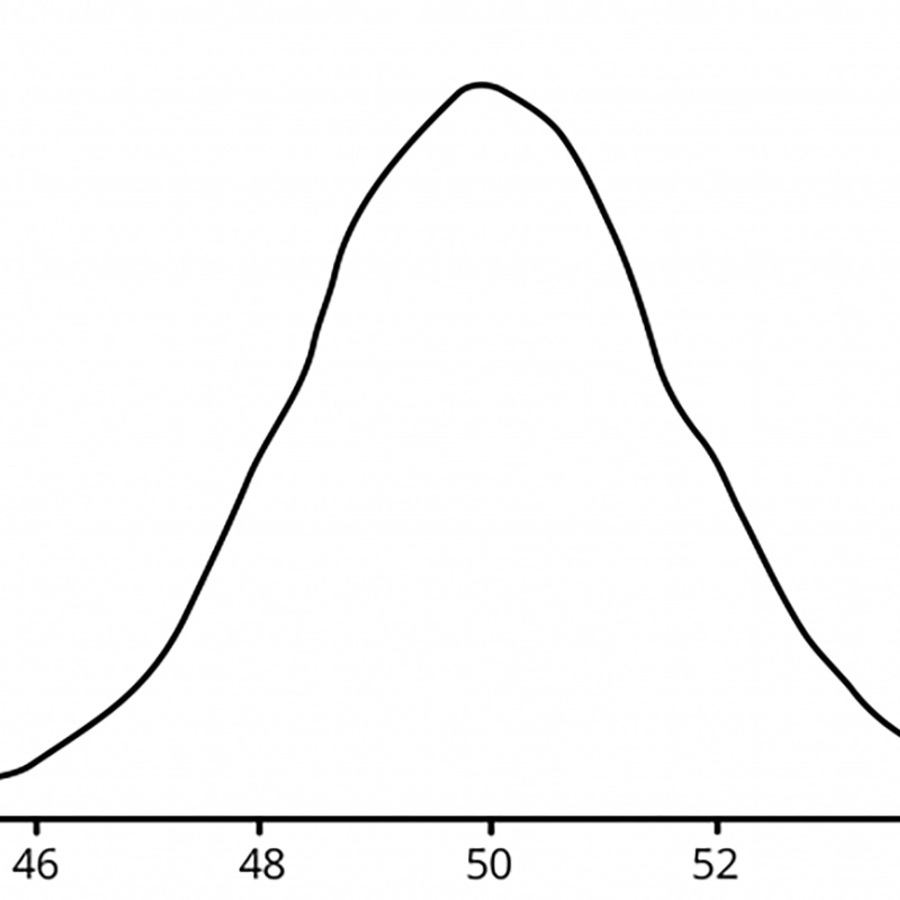
How much DNA do you really share with a sibling? Is 50% just an average?
March 6, 2013

- Related Topics:
- Relatedness,
- Recombination
A high school student from the United Kingdom asks:
“I know that a person is 50% related to their mom and 50% related to their dad. My question is whether or not siblings could range from 0-100% related? Is the 50% that people talk about with brothers and sisters just a mean value?”
You are right. Everyone is more or less 50% related to each of their parents, but could theoretically be anywhere from 0-100% related to their siblings. But for reasons we will talk about in a bit, it turns out we are all pretty much 50% related to our brothers and sisters too.
Both of these are true because of how DNA is passed from one generation to the next. We get half our DNA from our moms and half from our dads. Which is why simple biology says we are more or less 50% related to our parents.
The “more or less” comes from the X and Y chromosomes that come from dad and the mitochondrial DNA that comes from mom. These slightly change the 50%, but they do so in a consistent way.
Boys are always related to their dads at a certain percentage and their moms at a slightly different percentage. Same thing with daughters and their moms and dads.
The situation is much more variable with siblings. Theoretically you could be totally unrelated to your sister, or share the exact same DNA as your brother! But because we are talking about so much DNA and so many different possible combinations, the percentage usually comes out to about 50%.

Think about it like flipping a coin. Imagine mom is heads and dad is tails. If you flip the coin just twice, then you have a 1 in 4 chance of getting two heads, a 1 in 4 chance of getting two tails and a 2 in 4 (or 1 in 2) chance of getting a head and a tail. You’d have a pretty good shot at being the same as one parent or the other.
But if you flip a coin a thousand times, the odds of getting all heads or all tails is pretty close to zero. Not exactly zero, but very close. Here is what the graph of probabilities looks like for a thousand coin flips:

You can see that 499 heads and 501 tails isn’t that much less likely than 500 of each. Once you get to 450 heads, though, you get down to very low probabilities. And at one or zero heads, you are a whisker above zero.
The same sort of thing is true with our DNA. Because there are so many possible combinations of mom’s and dad’s DNA in each sibling, the siblings all tend to be pretty close to 50% related. Here is what the graph would look like:

Around 50% Related
Our DNA is packaged in 23 pairs of chromosomes. We get one of each pair from mom and one from dad. This is how we get to 46 chromosomes.
It is also why we are 50% related to mom and 50% related to dad. One chromosome from each pair comes from each parent. But it doesn’t work like you might think.
See, the chromosome you get from mom is actually a mix of both chromosomes in the pair. It goes something like this:
![]()
When you get this chromosome from mom, it is still all mom DNA. So when it pairs up with the one from dad, you end up with half your DNA from mom and half from dad. The same thing happens with 21 of your other pairs (we’ll deal with the 23rd pair and a bit of DNA from the mitochondria called mtDNA later).
The way I drew the mixing is just one of an infinite variety of ways the DNA could have mixed. Here are four more:

This sort of recombination is why siblings don’t have to be exactly 50% related. Let’s go through a couple of examples to see why.
Imagine that mom’s chromosomes mix in the way shown below for a brother and a sister:

As you can see, by chance they share no DNA on this chromosome. The brother got the top and bottom half of the blue chromosome and the middle of the red one. By chance, the sister got just the opposite. If this were to happen with the rest of the chromosomes, then by chance they’d share no DNA from mom!
Let’s look at this example:

Now they each got the same DNA from mom and so happen to share all of their DNA on this chromosome. If this were to happen on all of the chromosomes too, then these two would be 100% identical for mom’s DNA.
For the siblings to share all or none of their DNA, the same sort of things would have to happen with dad’s chromosomes too. The odds are very much against the exact same mixing happening on all 46 chromosomes in each of the siblings. So unlikely that I have never seen a report of where such a thing has happened (although something called uniparental disomy can make a child share more DNA with one parent).
What happens in real life is that there are different amounts of mixing that when averaged over the 46 chromosomes comes to about 50%. You can see this is in these two real life examples:

In this picture, we are comparing a sister to two different brothers. It is presented in sort of a weird way because of the way this company is able to look at the DNA but the bottom line is that even though the patterns are very different, each brother shares about the same amount of DNA with their sister. Let’s look at these results in a little more detail.
Wherever part of a chromosome is black, that means the two people share DNA from both parents in this pair of chromosomes. In other words, they happened to get the same chunk of DNA from mom and dad. They are completely identical at this spot.
In the gray parts, they are half identical which means they share DNA from either mom or dad at this spot but got different DNA from the other parent. And if the DNA is white, they got different DNA from both parents.
OK, I know what that is supposed to mean and I’m a little confused. Let me take chromosome 2 from the first set and try to show you what it means.
First, let’s take their chromosome and flip it so it is like the others in the answer so far. Here is what that will look like:

OK, so this is actually four separate chromosomes all being compared at once. The first step is to pull those four out like this:

Now let’s add in mom and dad’s DNA. We will make each one of their chromosomes a different color.

What I have also done is to show one way mom and dad’s DNA might have mixed in this brother and sister to give the result on the left. This isn’t the only way it could happen but it’ll help us understand the results (I hope!). Let’s go through and see how it works.

What I have done is to box in the areas where the brother and sister have half identical DNA on both the 23andMe diagram and my example. Notice the top box that is supposed to match up with the top light blue in the chromosome on the left. (I ignored the little white patch for simplicity.)
Both brother and sister got green from dad in this section but the brother got blue from mom and the sister got red. So they are different at mom’s chromosomes and the same at dad’s. They are half identical.
Same thing with the next box except here they share mom’s red DNA but have different dad’s DNA. Again, they are half identical.
Here is an image where the nonidentical DNA has been boxed:

Let’s look at the uppermost box. Notice that none of the brother’s and sister’s DNA matches up. The brother got blue from mom and yellow from dad and the sister got red from mom and green from dad. They are nonidentical here.
Finally let’s look at the areas where their DNA is identical.

Notice how in the uppermost box, the brother and the sister both got red from mom and yellow from dad. They are identical at this pair of chromosomes.
OK, now maybe the data below is easier to understand!

The key point here is that even though the two brothers have a very different pattern when compared to their sister, they share about the same amount of DNA with her.
If you look at the box in each figure, you’ll see how many gigabases (or billions of bases of DNA) the two share. This sister shares 1.98 with one brother and 1.93 with the other. Nearly identical amounts!
Again, this is because there are so many different combinations that it all sort of balances out in the end. Kind of like doing thousands of coin flips. And these results are pretty typical.
So for the first 22 pairs of chromosomes which represent most of our DNA, two siblings are going to share right around half of their DNA. Not exactly half, but pretty close.
Since these chromosomes make up the lion share of our DNA, we could be done here. But for completeness sake, we’ll include a short section on the 23rd pair and the DNA from the mitochondria. Different siblings share a definite amount of each of these.
X, Y, and mtDNA
We’ll start with the easy one first, the mitochondrial (mtDNA). Since mtDNA is only passed from mother to child, all siblings share the same amount of this DNA.
This DNA isn’t really that significant in terms of percentages. The mtDNA only makes up a little less that 0.0003% of your total DNA so this isn’t going to move the percentage too far one way or the other.
The other important differences are the X that dads pass to their daughters and the Y’s they pass to their sons. Because these don’t recombine, sisters pretty much share 100% of their X chromosomes and brothers share 100% of their Y chromosomes with their dads.

Author: Dr. Barry Starr
Barry served as The Tech Geneticist from 2002-2018. He founded Ask-a-Geneticist, answered thousands of questions submitted by people from all around the world, and oversaw and edited all articles published during his tenure. AAG is part of the Stanford at The Tech program, which brings Stanford scientists to The Tech to answer questions for this site, as well as to run science activities with visitors at The Tech Interactive in downtown San Jose.
 Skip Navigation
Skip Navigation
